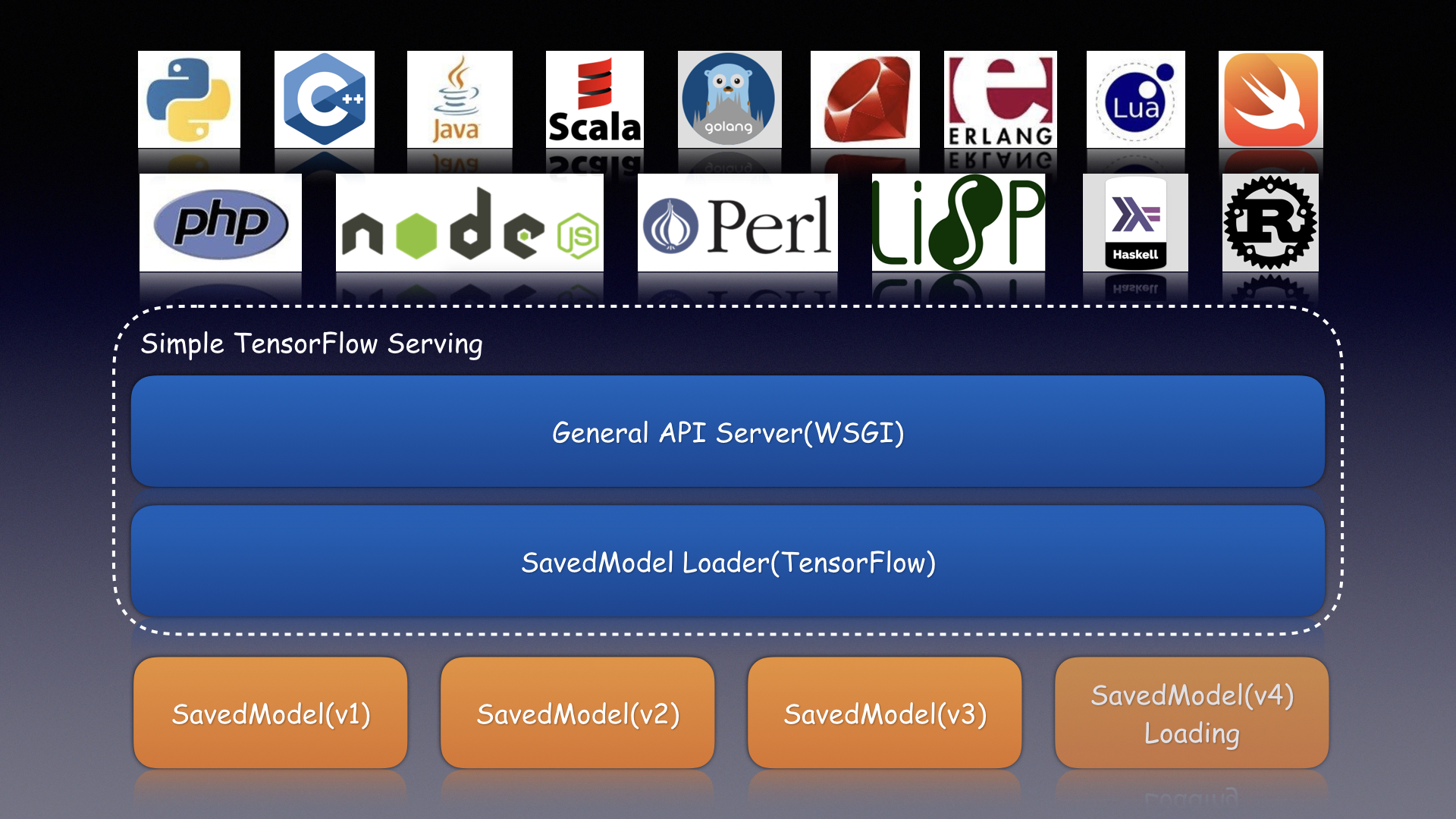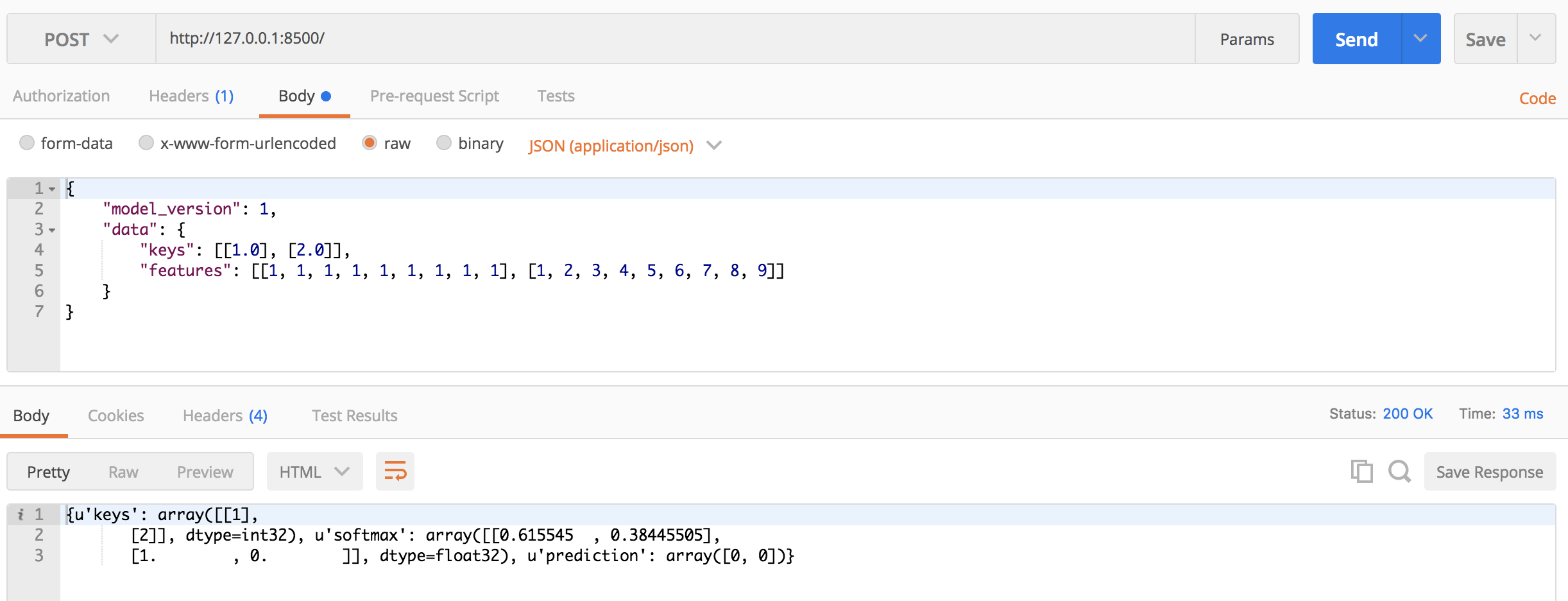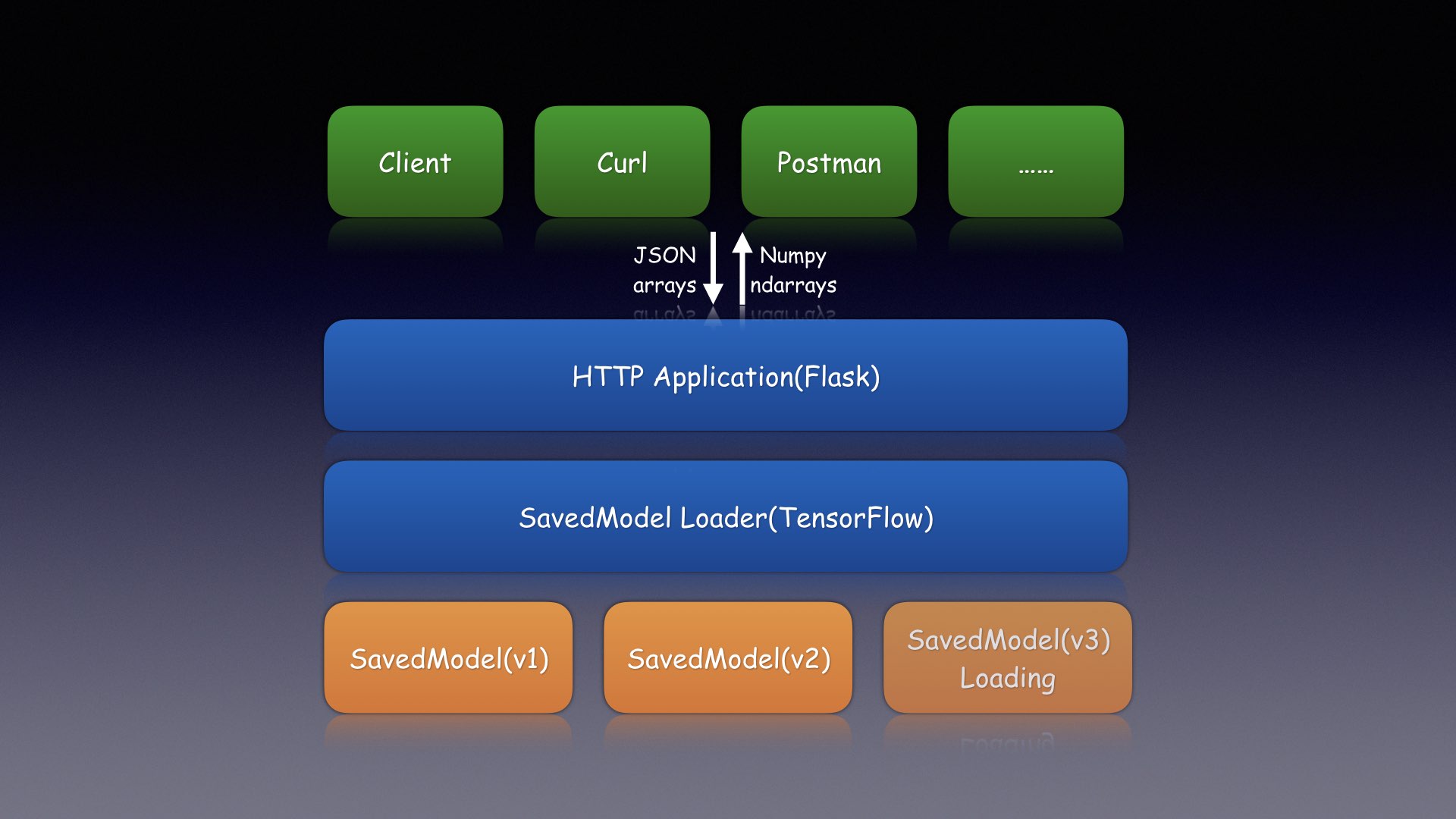Simple TensorFlow Serving is the generic and easy-to-use serving service for machine learning models.
It is the bridge for TensorFlow models and bring machine learning to any programming language, such as Bash, Python, C++, Java, Scala, Go, Ruby, JavaScript, PHP, Erlang, Lua, Rust, Swift, Perl, Lisp, Haskell, Clojure, R and so on.
- Support distributed TensorFlow models
- Support the general RESTful/HTTP APIs
- Support inference with accelerated GPU
- Support
curland other command-line tools - Support clients in any programming language
- Support code-gen SDKs by models without coding
- Support inference for image models with raw file
- Support statistical metrics for verbose requests
- Support serving multiple models at the same time
- Support dynamic online and offline for model versions
- Support secure authentication with configurable basic auth
Install the server with pip.
pip install simple-tensorflow-servingOr install with bazel.
bazel build simple_tensorflow_serving:serverOr install from source code.
python ./setup.py installOr use official docker image.
docker run -d -p 8501:8500 tobegit3hub/simple_tensorflow_servingStart the server with the exported SavedModel.
simple_tensorflow_serving --port=8500 --model_base_path="./models/tensorflow_template_application_model"Check out the dashboard in http://127.0.0.1:8500 in your browser.
Then access the TensorFlow model and inference with test dataset.
curl -H "Content-Type: application/json" -X POST -d '{"data": {"keys": [[1.0], [2.0]], "features": [[10, 10, 10, 8, 6, 1, 8, 9, 1], [6, 2, 1, 1, 1, 1, 7, 1, 1]]}}' http://127.0.0.1:8500Here is the example client in Bash.
curl -H "Content-Type: application/json" -X POST -d '{"data": {"keys": [[1.0], [2.0]], "features": [[10, 10, 10, 8, 6, 1, 8, 9, 1], [6, 2, 1, 1, 1, 1, 7, 1, 1]]}}' http://127.0.0.1:8500Here is the example client in Python.
endpoint = "http://127.0.0.1:8500"
payload = {"data": {"keys": [[11.0], [2.0]], "features": [[1, 1, 1, 1, 1, 1, 1, 1, 1], [1, 1, 1, 1, 1, 1, 1, 1, 1]]}}
result = requests.post(endpoint, json=payload)Here is the example client in C++.
Here is the example client in Java.
Here is the example client in Scala.
Here is the example client in Go.
endpoint := "http://127.0.0.1:8500"
dataByte := []byte(`{"data": {"keys": [[11.0], [2.0]], "features": [[1, 1, 1, 1, 1, 1, 1, 1, 1], [1, 1, 1, 1, 1, 1, 1, 1, 1]]}}`)
var dataInterface map[string]interface{}
json.Unmarshal(dataByte, &dataInterface)
dataJson, _ := json.Marshal(dataInterface)
resp, err := http.Post(endpoint, "application/json", bytes.NewBuffer(dataJson))Here is the example client in Ruby.
endpoint = "http://127.0.0.1:8500"
uri = URI.parse(endpoint)
header = {"Content-Type" => "application/json"}
input_data = {"data" => {"keys"=> [[11.0], [2.0]], "features"=> [[1, 1, 1, 1, 1, 1, 1, 1, 1], [1, 1, 1, 1, 1, 1, 1, 1, 1]]}}
http = Net::HTTP.new(uri.host, uri.port)
request = Net::HTTP::Post.new(uri.request_uri, header)
request.body = input_data.to_json
response = http.request(request)Here is the example client in JavaScript.
var options = {
uri: "http://127.0.0.1:8500",
method: "POST",
json: {"data": {"keys": [[11.0], [2.0]], "features": [[1, 1, 1, 1, 1, 1, 1, 1, 1], [1, 1, 1, 1, 1, 1, 1, 1, 1]]}}
};
request(options, function (error, response, body) {});Here is the example client in PHP.
$endpoint = "127.0.0.1:8500";
$inputData = array(
"keys" => [[11.0], [2.0]],
"features" => [[1, 1, 1, 1, 1, 1, 1, 1, 1], [1, 1, 1, 1, 1, 1, 1, 1, 1]],
);
$jsonData = array(
"data" => $inputData,
);
$ch = curl_init($endpoint);
curl_setopt_array($ch, array(
CURLOPT_POST => TRUE,
CURLOPT_RETURNTRANSFER => TRUE,
CURLOPT_HTTPHEADER => array(
"Content-Type: application/json"
),
CURLOPT_POSTFIELDS => json_encode($jsonData)
));
$response = curl_exec($ch);Here is the example client in Erlang.
ssl:start(),
application:start(inets),
httpc:request(post,
{"http://127.0.0.1:8500", [],
"application/json",
"{\"data\": {\"keys\": [[11.0], [2.0]], \"features\": [[1, 1, 1, 1, 1, 1, 1, 1, 1], [1, 1, 1, 1, 1, 1, 1, 1, 1]]}}"
}, [], []).Here is the example client in Lua.
local endpoint = "http://127.0.0.1:8500"
keys_array = {}
keys_array[1] = {1.0}
keys_array[2] = {2.0}
features_array = {}
features_array[1] = {1, 1, 1, 1, 1, 1, 1, 1, 1}
features_array[2] = {1, 1, 1, 1, 1, 1, 1, 1, 1}
local input_data = {
["keys"] = keys_array,
["features"] = features_array,
}
local json_data = {
["data"] = input_data
}
request_body = json:encode (json_data)
local response_body = {}
local res, code, response_headers = http.request{
url = endpoint,
method = "POST",
headers =
{
["Content-Type"] = "application/json";
["Content-Length"] = #request_body;
},
source = ltn12.source.string(request_body),
sink = ltn12.sink.table(response_body),
}Here is the example client in Rust.
Here is the example client in Swift.
Here is the example client in Perl.
my $endpoint = "http://127.0.0.1:8500";
my $json = '{"data": {"keys": [[11.0], [2.0]], "features": [[1, 1, 1, 1, 1, 1, 1, 1, 1], [1, 1, 1, 1, 1, 1, 1, 1, 1]]}}';
my $req = HTTP::Request->new( 'POST', $endpoint );
$req->header( 'Content-Type' => 'application/json' );
$req->content( $json );
$ua = LWP::UserAgent->new;
$response = $ua->request($req);Here is the example client in Lisp.
Here is the example client in Haskell.
Here is the example client in Clojure.
Here is the example client in R.
endpoint <- "http://127.0.0.1:8500"
body <- list(data = list(a = 1), keys = 1)
json_data <- list(
data = list(
keys = list(list(1.0), list(2.0)), features = list(list(1, 1, 1, 1, 1, 1, 1, 1, 1), list(1, 1, 1, 1, 1, 1, 1, 1, 1))
)
)
r <- POST(endpoint, body = json_data, encode = "json")
stop_for_status(r)
content(r, "parsed", "text/html")Here is the example with Postman.
You can also generate SDK in different languages(Bash, Python, Golang, JavaScript etc.) for your model without writing any code.
simple_tensorflow_serving --model_base_path="./models/tensorflow_template_application_model/" --gen_sdk bashsimple_tensorflow_serving --model_base_path="./models/tensorflow_template_application_model/" --gen_sdk pythonThe generated code should look like these which can be test immediately.
#!/bin/bash
curl -H "Content-Type: application/json" -X POST -d '{"data": {"keys": [[1.0], [1.0]], "features": [[1.0, 1.0, 1.0, 1.0, 1.0, 1.0, 1.0, 1.0, 1.0], [1.0, 1.0, 1.0, 1.0, 1.0, 1.0, 1.0, 1.0, 1.0]]} }' http://127.0.0.1:8500#!/usr/bin/env python
import requests
def main():
endpoint = "http://127.0.0.1:8500"
input_data = {"keys": [[1.0], [1.0]], "features": [[1.0, 1.0, 1.0, 1.0, 1.0, 1.0, 1.0, 1.0, 1.0], [1.0, 1.0, 1.0, 1.0, 1.0, 1.0, 1.0, 1.0, 1.0]]}
result = requests.post(endpoint, json=input_data)
print(result.text)
if __name__ == "__main__":
main()For image models, we can request with the raw image files instead of constructing array data.
Now start serving the image model like deep_image_model.
simple_tensorflow_serving --model_base_path="../models/deep_image_model/"Then request with the raw image file which has the same shape of your model.
curl -X POST -F 'image=@./images/mew.jpg' -F "model_version=1" 127.0.0.1:8500For enterprises, we can enable basic auth for all the APIs and any anonymous request is denied.
Now start the server with the configured username and password.
./server.py --model_base_path="../models/tensorflow_template_application_model/" --enable_auth=True --auth_username="admin" --auth_password="admin"If you are using the Web dashboard, just type your certification. If you are using clients, give the username and password within the request.
curl -u admin:admin -H "Content-Type: application/json" -X POST -d '{"data": {"keys": [[11.0], [2.0]], "features": [[1, 1, 1, 1, 1, 1, 1, 1, 1], [1, 1, 1, 1, 1, 1, 1, 1, 1]]}}' http://127.0.0.1:8500
endpoint = "http://127.0.0.1:8500"
input_data = {
"data": {
"keys": [[11.0], [2.0]],
"features": [[1, 1, 1, 1, 1, 1, 1, 1, 1], [1, 1, 1, 1, 1, 1, 1, 1, 1]]
}
}
auth = requests.auth.HTTPBasicAuth("admin", "admin")
result = requests.post(endpoint, json=input_data, auth=auth)simple_tensorflow_servingstarts the HTTP server withflaskapplication.- Load the TensorFlow models with
tf.saved_model.loaderPython API. - Construct the feed_dict data from the JSON body of the request.
// Method: POST, Content-Type: application/json { "model_version": 1, // Optional "data": { "keys": [[1.0], [2.0]], "features": [[10, 10, 10, 8, 6, 1, 8, 9, 1], [6, 2, 1, 1, 1, 1, 7, 1, 1]] } } - Use the TensorFlow Python API to
sess.run()with feed_dict data. - For multiple versions supported, it starts independent thread to load models.
- For generated SDKs, it reads user's model and render code with Jinja templates.
Check out the C++ implementation of TensorFlow Serving in tensorflow/serving.
Feel free to open an issue or send pull request for this project. It is warmly welcome to add more clients in your languages to access TensorFlow models.



